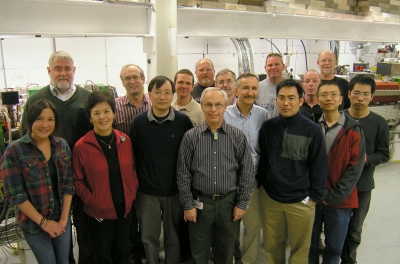
At right: The researchers and developers of the Duke FEL and HIGS, including physicists, graduate students, engineers, technicians, and administrative staff. The group is inside the booster synchrotron, a full-energy injector into the storage ring. The synchrotron was the major addition to the accelerator facility constructed as part of the recent upgrade completed in 2007.
The recently upgraded HIGS facility on Duke’s campus has become the world’s most powerful Compton gamma-ray source. HIGS—the “high intensity gamma-ray source”—is part of the Triangle Universities Nuclear Laboratory (TUNL), which is located at Duke.
Physicists from around the world come to use the gamma-ray beam for a wide variety of measurements. For more information on one of these experiments, see “HIGS Plays Role in Nuclear Fusion Research.” The machinery that produces the gamma rays was originally constructed in the early 1990s to generate free electron laser (FEL) beams, but now research involving high-energy gamma rays is attracting more funding. “The HIGS has become our primary operating capability,” says Professor Ying Wu. “Typically, we provide the beam on target [for research groups] for 1,800-2,000 hours a year.” Wu is associate professor and a TUNL associate director for accelerators and light sources at the FEL laboratory. The facility still generates FEL beams, because they are a critical ingredient in making gamma rays. In a race-track storage ring that has a circumference of more than 100 meters, a stream of electrons moves close to the speed of light. On one side of the storage ring, two magnetic “wigglers” cause the electrons to emit a stream of photons. These photons are trapped inside a pair of high-reflectivity mirrors, forming the FEL beam. If the FEL beam collides head on with the stream of electrons, the collision creates gamma rays by a process known as Compton scattering. “The first production of a gamma-ray beam at our lab can go back to 1996, but it was very low intensity,” Wu says. “We got funding from the Department of Energy to upgrade the capability of the gamma-ray beam.” In addition to the DOE funding, the three universities in the TUNL consortium—Duke, North Carolina State University, and the University of North Carolina at Chapel Hill—contributed substantially to the project. Those upgrades were completed in 2007, followed by further improvements to increase the intensity of the FEL beam and electron beam. In 2010, the lab reached two milestones.
First, the facility produced a gamma-ray beam with a total intensity of 2 x 10 10 gammas per second with an energy of around 10 MeV (million electron volts). Then, in the fall, HIGS scientists produced a gamma-ray beam with an energy of 100 MeV after producing an FEL beam with a wavelength of around 190 nanometers (in the vacuum ultraviolet range). The new capabilities at HIGS open up new opportunities for basic research. The high-intensity, high-energy gamma rays make possible experiments aimed at providing new information about the structure of protons and neutrons. The high-intensity, low-energy gamma-ray beams can be used to help understand the nucleosynthesis of elements in the periodic table, the evolution of stellar burning processes, and the structure of the nucleus. There are practical applications as well, including using gamma rays as an imaging technology in industrial and medical diagnostics and for inspection of nuclear materials in closed cargo containers, and as a source to calibrate next-generation gamma-ray detectors including those used in satellite gamma-ray telescopes. Wu has been involved with the FEL and HIGS for about 20 years. He came to Duke from China as a graduate student in 1988 and earned his PhD here in 1995. He spent two years at the Lawrence Berkeley National Lab as a staff scientist, and returned to Duke in 2001 as a faculty member. “This is the only dedicated Compton gamma-ray facility in the world,” Wu says. “We’re proud of our capabilities and intensities. We are producing intense, monochromatic, and polarized gamma-ray beams from 1 to 100 MeV.” He and his colleagues are working hard to develop new capabilities at the facility to ensure that HIGS remains a worldwide leader in its field for years to come. View more photos on the Physics Department Flickr site by clicking here.